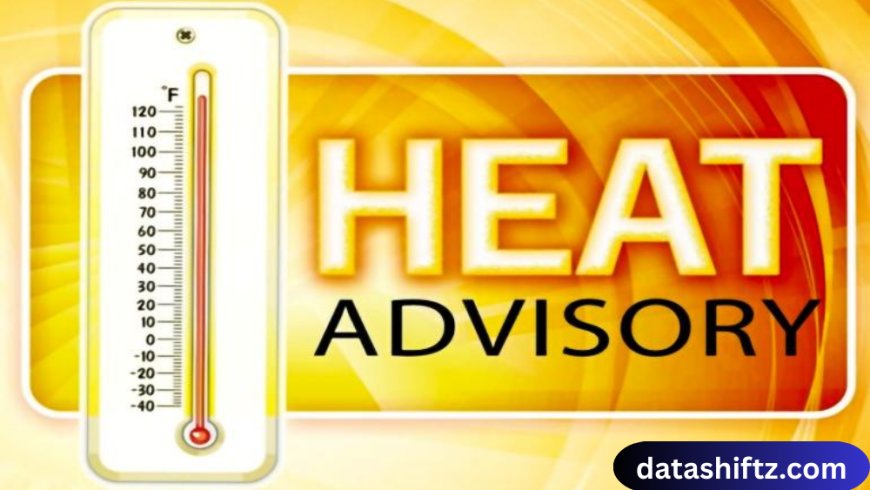Heat Advisory: Understanding Extreme Heat and Staying Safe

Introduction
Heat waves have become increasingly common due to climate change, and communities across the globe are experiencing longer, hotter summers. To protect the public during periods of dangerous heat, meteorological departments issue heat advisories. A heat advisory is more than just a weather warning—it is a call to action, urging people to take precautions and protect themselves from heat-related illnesses such as dehydration, heat exhaustion, and heatstroke.
This article explores the concept of a heat advisory, its causes, health risks, safety measures, and how communities can prepare for extreme heat events.
What is a Heat Advisory?
A heat advisory is an official weather alert issued by agencies like the National Weather Service (NWS) in the United States or similar organizations worldwide. It is triggered when temperatures and humidity levels combine to create a heat index that poses health risks.
The heat index is essentially what the temperature “feels like” when humidity is factored in. For example, if the air temperature is 95°F (35°C) but the humidity is high, the heat index could feel like 105°F (40°C) or more.
Criteria for a Heat Advisory
-
Issued when the heat index reaches 100–105°F (37–41°C) for at least two consecutive days.
-
Some regions adjust thresholds based on local climate norms.
-
Often followed by Excessive Heat Warnings if conditions worsen.
Health Risks During a Heat Advisory
Extreme heat affects the body in dangerous ways. It strains the heart, reduces hydration, and can quickly escalate into medical emergencies if precautions aren’t taken.
Common Heat-Related Illnesses
-
Heat Cramps – Painful muscle spasms due to loss of salt and water.
-
Heat Exhaustion – Symptoms include heavy sweating, weakness, nausea, and dizziness.
-
Heatstroke – A life-threatening condition where body temperature rises above 104°F (40°C).
Heat Advisory vs. Excessive Heat Warning
| Alert Type | Criteria | Health Impact | Recommended Action |
|---|---|---|---|
| Heat Advisory | Heat index 100–105°F (37–41°C) for 1–2 days | Moderate risk of heat-related illness | Stay hydrated, limit outdoor activity |
| Excessive Heat Warning | Heat index ≥ 105°F (41°C) for extended duration | High risk of heatstroke, severe illness | Avoid outdoor activity, seek AC, check on vulnerable groups |
Safety Precautions During a Heat Advisory
Stay Hydrated
Water is the body’s best defense against extreme heat. Drink fluids regularly, even if you don’t feel thirsty. Avoid alcohol and excessive caffeine, which can increase dehydration.
Limit Outdoor Activity
If possible, avoid strenuous exercise or work during the hottest part of the day (10 a.m. to 4 p.m.). If outdoor activity is unavoidable, take frequent breaks in the shade.
Protect Vulnerable Groups
Children, the elderly, and those with chronic illnesses are most at risk. Communities should set up cooling centers for people without air conditioning.
Top 10 Tips to Stay Safe During a Heat Advisory
-
Drink plenty of water and electrolyte-rich fluids.
-
Wear lightweight, light-colored clothing.
-
Stay indoors during peak heat hours.
-
Use fans and air conditioning when possible.
-
Take cool showers or baths to lower body temperature.
-
Never leave children or pets in parked cars.
-
Eat smaller, lighter meals to reduce body heat.
-
Check on neighbors, especially the elderly.
-
Limit strenuous outdoor activities.
-
Follow official weather updates and alerts.
Community and Government Role
Heat advisories are not just personal concerns—they are public safety issues. Governments often respond by:
-
Opening public cooling shelters.
-
Extending public pool hours.
-
Encouraging employers to adjust work schedules for outdoor laborers.
-
Broadcasting safety messages through media and social networks.
Community cooperation is critical. Checking on vulnerable neighbors, volunteering at local shelters, and spreading awareness all help reduce the impact of dangerous heat events.
Long-Term Impact of Rising Heat
Heat advisories are becoming more frequent due to global warming. Rising greenhouse gas emissions are increasing the intensity of heat waves, pushing health systems and infrastructure to adapt. Cities with limited greenery or high urban density often experience the urban heat island effect, making heat advisories even more critical.
Long-term solutions include:
-
Expanding green spaces.
-
Improving building designs with heat-resistant materials.
-
Strengthening early warning systems.
Conclusion
A heat advisory is more than a weather update—it is a vital public health alert. Ignoring such warnings can lead to dangerous, sometimes fatal, consequences. By staying hydrated, avoiding outdoor activity during peak heat, and looking after vulnerable groups, communities can reduce risks and save lives.
As climate change continues to make extreme heat events more common, understanding and respecting heat advisories is crucial. Protecting ourselves and our communities during these events is not only a matter of comfort but also survival.






























